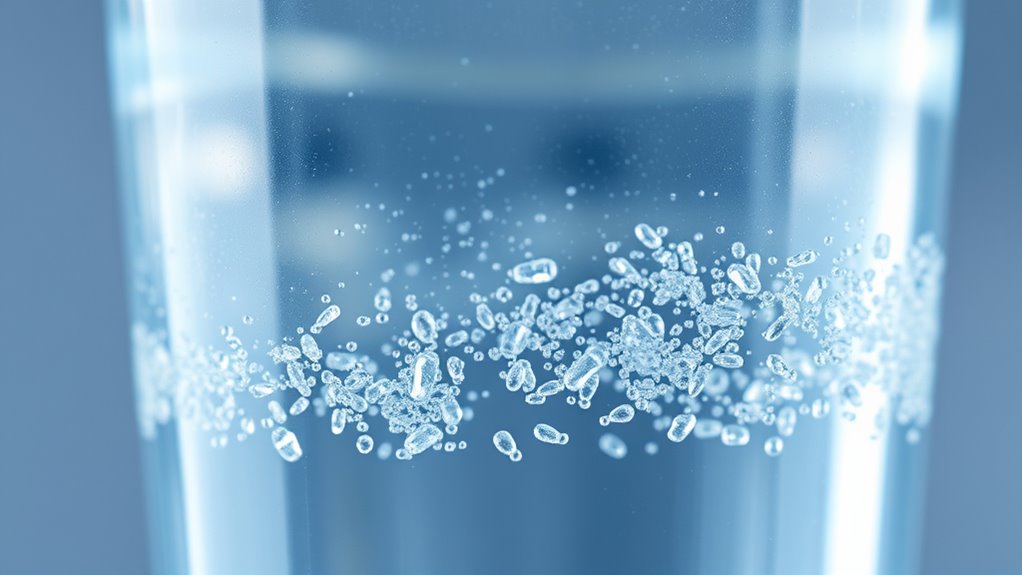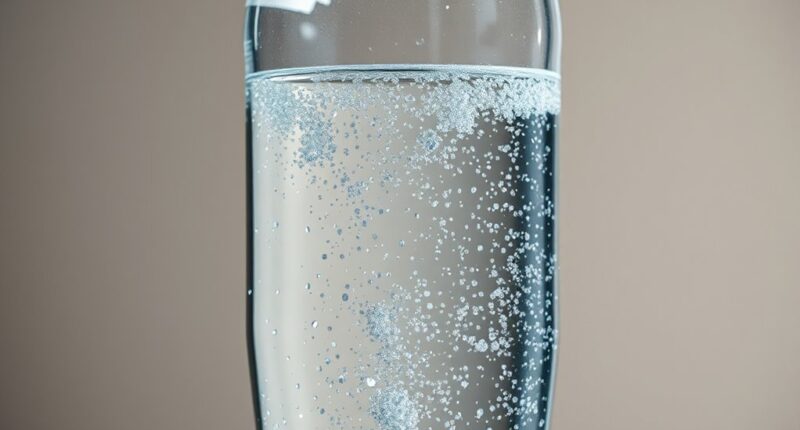Recent studies show that your bottled water may contain millions of tiny microplastics, which come from packaging, production, and environmental pollution. These small particles are difficult to remove with typical filters and can carry harmful chemicals or bacteria. Ingesting microplastics might cause health issues like inflammation and cellular damage over time. Understanding how widespread this contamination is can help you make smarter choices—continue exploring to see what steps you can take to protect yourself.
Key Takeaways
- Multiple studies reveal bottled water contains microplastics, often amounting to millions of particles per liter.
- Microplastics originate from plastic degradation, manufacturing, and packaging processes, contaminating bottled water globally.
- These tiny particles can carry harmful chemicals and bacteria, posing health risks upon ingestion.
- Microplastics can pass through the gut lining into the bloodstream, potentially affecting vital organs.
- Using quality filters or switching to trusted tap water can help reduce microplastic ingestion risks.

Many bottled water brands contain microplastics, tiny plastic particles that can pose health risks. These tiny particles result from plastic contamination, which occurs during various stages of the production, packaging, and distribution process. As you sip from your bottled water, you might not realize that you’re also ingesting millions of these microscopic plastics. Recent studies have shown that microplastics are pervasive in bottled water, regardless of brand or source, raising concerns about their potential health implications. When you consume water contaminated with microplastics, these particles can accumulate in your body over time, possibly leading to adverse health effects.
Many bottled waters contain microplastics, posing potential health risks with long-term ingestion.
The presence of microplastics in bottled water is alarming because plastic contamination is widespread in our environment. These tiny plastics originate from degraded larger plastic debris, manufacturing processes, or even the packaging materials themselves. Once in your bottled water, they are virtually impossible to remove through conventional filtration methods. The concern is not only the physical presence of microplastics but also the chemicals associated with plastics, such as additives or pollutants absorbed during environmental exposure. These chemicals can leach into the water and, once ingested, may interfere with your endocrine system, cause inflammation, or even disrupt cellular functions.
Understanding the health implications of ingesting microplastics is essential. While research is still ongoing, some studies suggest that microplastics can cause inflammation and oxidative stress in your body. There is also concern about the potential for these particles to carry harmful chemicals or bacteria, which may further threaten your health. Since microplastics are so small, they can pass through your gut lining and enter your bloodstream, possibly reaching critical organs. Long-term exposure could have cumulative effects, especially for vulnerable populations like children, pregnant women, or those with weakened immune systems. Additionally, high surface area-to-volume ratio makes microplastics more likely to adsorb and transport hazardous chemicals, compounding their health risks.
Furthermore, the widespread plastic contamination in bottled water highlights how pervasive plastic pollution has become. It’s not just about environmental impacts but also about your personal health. You might think bottled water is a safe, clean choice, but the reality is more complicated. Microplastics in your water can contribute to a range of health issues, and because they are so small, they often go unnoticed. To minimize your risk, consider using a high-quality water filter or switching to tap water from a trusted source, especially in areas where bottled water quality is questionable. Being aware of this contamination is the first step toward making informed decisions about your health and safety.
Frequently Asked Questions
How Do Microplastics Affect Human Health Long-Term?
You might wonder about the long-term effects of microplastic accumulation in your body. Microplastics can pose digestive health risks, potentially causing inflammation or disrupting your gut microbiome. Over time, these particles could also carry harmful chemicals that may lead to health issues like hormone disruption or increased cancer risk. Staying informed and minimizing plastic exposure helps protect your digestive health and overall well-being from the hidden dangers of microplastics.
Are Certain Bottled Water Brands Safer Regarding Microplastic Content?
When comparing bottled water brands, you should look for transparency in labeling, which can indicate better quality control. Some brands might be safer regarding microplastic content, but without clear information, it’s hard to tell. You can reduce risks by choosing brands that provide detailed testing results and are committed to transparency. Ultimately, doing a brand comparison helps you make more informed choices about the water you consume.
Can Microplastics Be Removed From Bottled Water Through Filtering?
You might wonder if filtering can remove microplastics from bottled water. Research shows that filter effectiveness varies, but many high-quality filters can substantially reduce microplastic levels. While no filter removes every tiny particle, using a multi-stage filtration system increases microplastic removal. So, yes, filtering can help, but it’s crucial to choose a filter designed specifically for microplastic removal to guarantee you’re getting cleaner water.
How Do Microplastics Enter the Bottled Water Supply?
Microplastics enter the bottled water supply primarily through plastic leaching and water contamination during processing or packaging. As bottles are manufactured, tiny plastic particles can shed into the water, especially when exposed to heat or sunlight. Additionally, water sources may already contain microplastics from environmental pollution, which then get trapped in bottles. This ongoing plastic leaching and contamination process leads to microplastic presence in your bottled water.
What Regulations Exist to Limit Microplastic Levels in Bottled Water?
Currently, regulations on microplastic levels in bottled water are limited, revealing regulatory gaps. Industry standards vary globally, but many lack specific limits for microplastics, leaving consumers exposed. You should stay informed about these standards and advocate for stricter regulations, as industry oversight isn’t enough to guarantee safety. Strengthening regulations and closing gaps can better protect you from potential health risks associated with microplastic contamination.
Conclusion
Imagine opening a bottle of water, expecting pure clarity, only to find tiny, invisible microplastics swirling inside. These microscopic particles cling to your sip like ghostly remnants of plastic debris, silently invading your body with every gulp. The evidence shows your bottled water could be filled with millions of these minuscule intruders. So, next time you reach for that bottle, remember: what you can’t see might be the most dangerous of all, lurking just beneath the surface.










